1.11: Solutions
- Page ID
- 15515
\( \newcommand{\vecs}[1]{\overset { \scriptstyle \rightharpoonup} {\mathbf{#1}} } \)
\( \newcommand{\vecd}[1]{\overset{-\!-\!\rightharpoonup}{\vphantom{a}\smash {#1}}} \)
\( \newcommand{\id}{\mathrm{id}}\) \( \newcommand{\Span}{\mathrm{span}}\)
( \newcommand{\kernel}{\mathrm{null}\,}\) \( \newcommand{\range}{\mathrm{range}\,}\)
\( \newcommand{\RealPart}{\mathrm{Re}}\) \( \newcommand{\ImaginaryPart}{\mathrm{Im}}\)
\( \newcommand{\Argument}{\mathrm{Arg}}\) \( \newcommand{\norm}[1]{\| #1 \|}\)
\( \newcommand{\inner}[2]{\langle #1, #2 \rangle}\)
\( \newcommand{\Span}{\mathrm{span}}\)
\( \newcommand{\id}{\mathrm{id}}\)
\( \newcommand{\Span}{\mathrm{span}}\)
\( \newcommand{\kernel}{\mathrm{null}\,}\)
\( \newcommand{\range}{\mathrm{range}\,}\)
\( \newcommand{\RealPart}{\mathrm{Re}}\)
\( \newcommand{\ImaginaryPart}{\mathrm{Im}}\)
\( \newcommand{\Argument}{\mathrm{Arg}}\)
\( \newcommand{\norm}[1]{\| #1 \|}\)
\( \newcommand{\inner}[2]{\langle #1, #2 \rangle}\)
\( \newcommand{\Span}{\mathrm{span}}\) \( \newcommand{\AA}{\unicode[.8,0]{x212B}}\)
\( \newcommand{\vectorA}[1]{\vec{#1}} % arrow\)
\( \newcommand{\vectorAt}[1]{\vec{\text{#1}}} % arrow\)
\( \newcommand{\vectorB}[1]{\overset { \scriptstyle \rightharpoonup} {\mathbf{#1}} } \)
\( \newcommand{\vectorC}[1]{\textbf{#1}} \)
\( \newcommand{\vectorD}[1]{\overrightarrow{#1}} \)
\( \newcommand{\vectorDt}[1]{\overrightarrow{\text{#1}}} \)
\( \newcommand{\vectE}[1]{\overset{-\!-\!\rightharpoonup}{\vphantom{a}\smash{\mathbf {#1}}}} \)
\( \newcommand{\vecs}[1]{\overset { \scriptstyle \rightharpoonup} {\mathbf{#1}} } \)
\( \newcommand{\vecd}[1]{\overset{-\!-\!\rightharpoonup}{\vphantom{a}\smash {#1}}} \)
\(\newcommand{\avec}{\mathbf a}\) \(\newcommand{\bvec}{\mathbf b}\) \(\newcommand{\cvec}{\mathbf c}\) \(\newcommand{\dvec}{\mathbf d}\) \(\newcommand{\dtil}{\widetilde{\mathbf d}}\) \(\newcommand{\evec}{\mathbf e}\) \(\newcommand{\fvec}{\mathbf f}\) \(\newcommand{\nvec}{\mathbf n}\) \(\newcommand{\pvec}{\mathbf p}\) \(\newcommand{\qvec}{\mathbf q}\) \(\newcommand{\svec}{\mathbf s}\) \(\newcommand{\tvec}{\mathbf t}\) \(\newcommand{\uvec}{\mathbf u}\) \(\newcommand{\vvec}{\mathbf v}\) \(\newcommand{\wvec}{\mathbf w}\) \(\newcommand{\xvec}{\mathbf x}\) \(\newcommand{\yvec}{\mathbf y}\) \(\newcommand{\zvec}{\mathbf z}\) \(\newcommand{\rvec}{\mathbf r}\) \(\newcommand{\mvec}{\mathbf m}\) \(\newcommand{\zerovec}{\mathbf 0}\) \(\newcommand{\onevec}{\mathbf 1}\) \(\newcommand{\real}{\mathbb R}\) \(\newcommand{\twovec}[2]{\left[\begin{array}{r}#1 \\ #2 \end{array}\right]}\) \(\newcommand{\ctwovec}[2]{\left[\begin{array}{c}#1 \\ #2 \end{array}\right]}\) \(\newcommand{\threevec}[3]{\left[\begin{array}{r}#1 \\ #2 \\ #3 \end{array}\right]}\) \(\newcommand{\cthreevec}[3]{\left[\begin{array}{c}#1 \\ #2 \\ #3 \end{array}\right]}\) \(\newcommand{\fourvec}[4]{\left[\begin{array}{r}#1 \\ #2 \\ #3 \\ #4 \end{array}\right]}\) \(\newcommand{\cfourvec}[4]{\left[\begin{array}{c}#1 \\ #2 \\ #3 \\ #4 \end{array}\right]}\) \(\newcommand{\fivevec}[5]{\left[\begin{array}{r}#1 \\ #2 \\ #3 \\ #4 \\ #5 \\ \end{array}\right]}\) \(\newcommand{\cfivevec}[5]{\left[\begin{array}{c}#1 \\ #2 \\ #3 \\ #4 \\ #5 \\ \end{array}\right]}\) \(\newcommand{\mattwo}[4]{\left[\begin{array}{rr}#1 \amp #2 \\ #3 \amp #4 \\ \end{array}\right]}\) \(\newcommand{\laspan}[1]{\text{Span}\{#1\}}\) \(\newcommand{\bcal}{\cal B}\) \(\newcommand{\ccal}{\cal C}\) \(\newcommand{\scal}{\cal S}\) \(\newcommand{\wcal}{\cal W}\) \(\newcommand{\ecal}{\cal E}\) \(\newcommand{\coords}[2]{\left\{#1\right\}_{#2}}\) \(\newcommand{\gray}[1]{\color{gray}{#1}}\) \(\newcommand{\lgray}[1]{\color{lightgray}{#1}}\) \(\newcommand{\rank}{\operatorname{rank}}\) \(\newcommand{\row}{\text{Row}}\) \(\newcommand{\col}{\text{Col}}\) \(\renewcommand{\row}{\text{Row}}\) \(\newcommand{\nul}{\text{Nul}}\) \(\newcommand{\var}{\text{Var}}\) \(\newcommand{\corr}{\text{corr}}\) \(\newcommand{\len}[1]{\left|#1\right|}\) \(\newcommand{\bbar}{\overline{\bvec}}\) \(\newcommand{\bhat}{\widehat{\bvec}}\) \(\newcommand{\bperp}{\bvec^\perp}\) \(\newcommand{\xhat}{\widehat{\xvec}}\) \(\newcommand{\vhat}{\widehat{\vvec}}\) \(\newcommand{\uhat}{\widehat{\uvec}}\) \(\newcommand{\what}{\widehat{\wvec}}\) \(\newcommand{\Sighat}{\widehat{\Sigma}}\) \(\newcommand{\lt}{<}\) \(\newcommand{\gt}{>}\) \(\newcommand{\amp}{&}\) \(\definecolor{fillinmathshade}{gray}{0.9}\)Climate change is a difficult problem to solve because our modern society was build with fossil fuel burning as an energy source. We still depend strongly on fossil fuel energy for everything from driving our cars and washing our laundry to charging our cell phones and heating our homes. In order to stabilize climate, however, we’ll need to move to near-zero carbon emissions in the long run. Thus, the challenge is to decarbonize our economy. The longer we wait with this transformation the larger the impacts of future climate change will be or the faster future emission reductions will need to be. And because it is a global problem the whole world, or at least most of it, will need to cooperate to solve it. Moreover, because we’re already committed to further climate change we better prepare to adapt to it. This chapter will discus technological options, political efforts and personal actions towards climate mitigation solutions and ways to adapt to the inevitable.
Figure \(\PageIndex{1}\) illustrates that historically the increase in carbon emissions was caused by human population growth and an increase in the economy as expressed by e.g. the Gross Domestic Product (GDP). Both population and GDP per person have increased exponentially during the past ~200 years. The increased use of fossil-fuel-based energy has lifted many people out of poverty and improved the lives of millions although many people in the developing world remain in poverty. Formally, anthropogenic carbon emissions ACE = P × GDP/P × E/GDP × CE/E in a certain region or country can be decomposed into the population P, the GDP per person (GDP/P), the energy intensity of GDP (E/GDP) and the carbon emissions per energy (CE/E). Energy intensity of GDP has been decreasing during the past 50 years, which compensated somewhat the increase in population and GDP per person, whereas carbon intensity has not changed as much as the other factors (IPCC, 2014, Figure SPM.3). This decomposition is known as the Kaya Identity. Currently the world population is almost 8 billion people and it is expected to continue to increase, at least for the near future. This increase will continue to put more pressures on the Earth system; climate change is just one of them. Others are, for example, increased occupation of wild places by humans, which reduces habitats for many species of plants and animals or increasing demand for resources such as food and fresh water. Population growth could be efficiently reduced by educating and empowering women in the developing world and by poverty reduction. Reducing the GDP per person is probably not a good way to reduce emissions, because most people do not want to reduce their standard of living and energy consumption (although some do and a lot of waste could also be cut without affecting our standard of living much). Since many people in the developing world hope to improve their standard of living it will be desirable to further increase the average GDP per person in the future. But if carbon emissions per energy could be reduced e.g. by shifting to non fossil fuel energy sources, that would reduce emissions without reducing GDP or energy consumption.
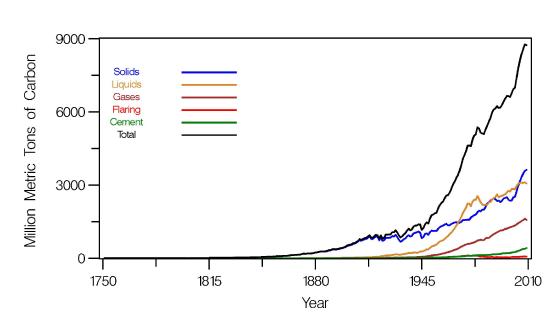
A
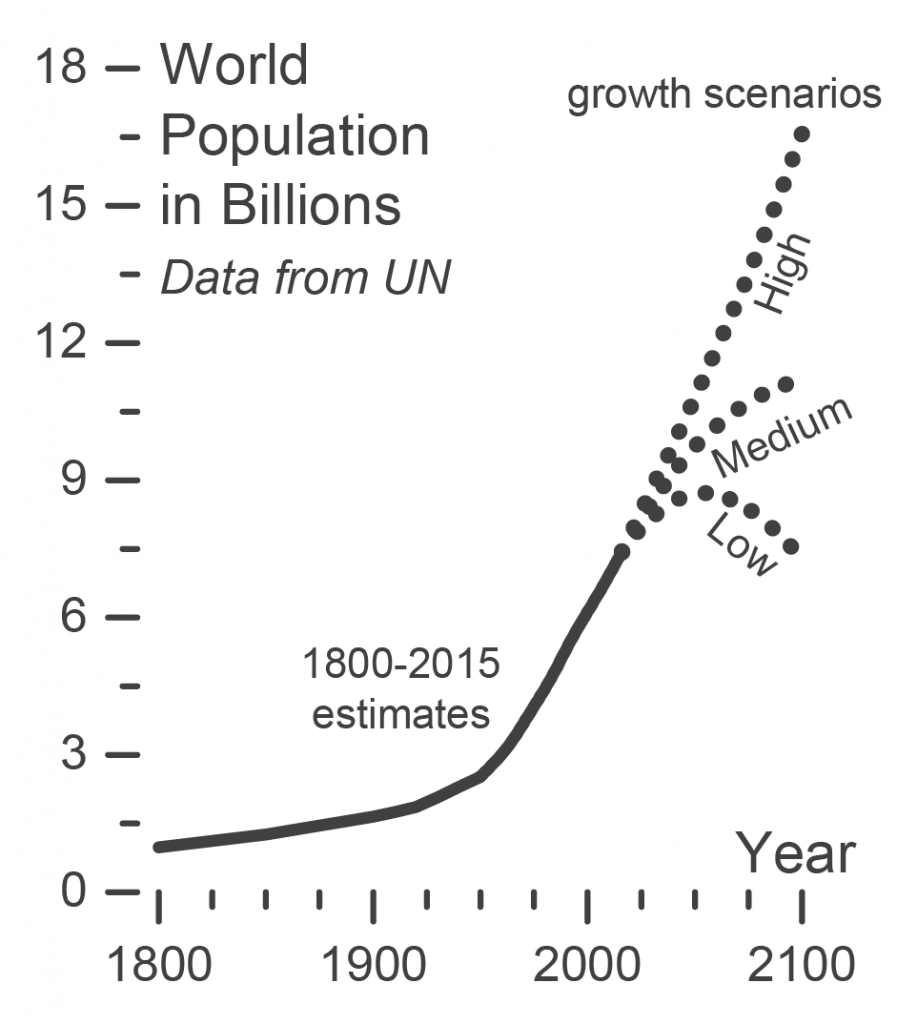
B

C
a) Technology
Current global energy production relies heavily on fossil fuel burning (Fig. \(\PageIndex{2}\) ). The largest energy sources are oil, coal and natural gas, all of which are fossil fuels, whereas all non-fossil fuel sources together account for only about 20% of the total. Most oil consumption powers internal combustion engines in cars and trucks, which have a very low efficiency. Only about 25% of all energy input into transportation is used to move vehicles, whereas most of the energy is wasted as heat. Coal is mainly used in power plants to generate electricity, which is also associated with a loss of a little over one half. Note that this loss is less than that from internal combustion engines, which makes electric cars have lower carbon footprints than internal combustion engine cars even if the electricity is generated from coal. Most natural gas is used to generate electricity and to heat buildings. Hydro- and nuclear power are used exclusively to produce electricity, whereas biomass is used mostly for cooking and heating homes in the developing world. New renewables such as solar and wind supply only a small fraction of all energy.

Figure \(\PageIndex{2}\): Energy flows in the world economy in 2005 in exajoules (1EJ = 1018J) per year from primary sources top to end-use sector (bottom). ALS = Autoconsumption, losses, stock changes. OTF = other transformation to secondary fuels. From GEA (2012).
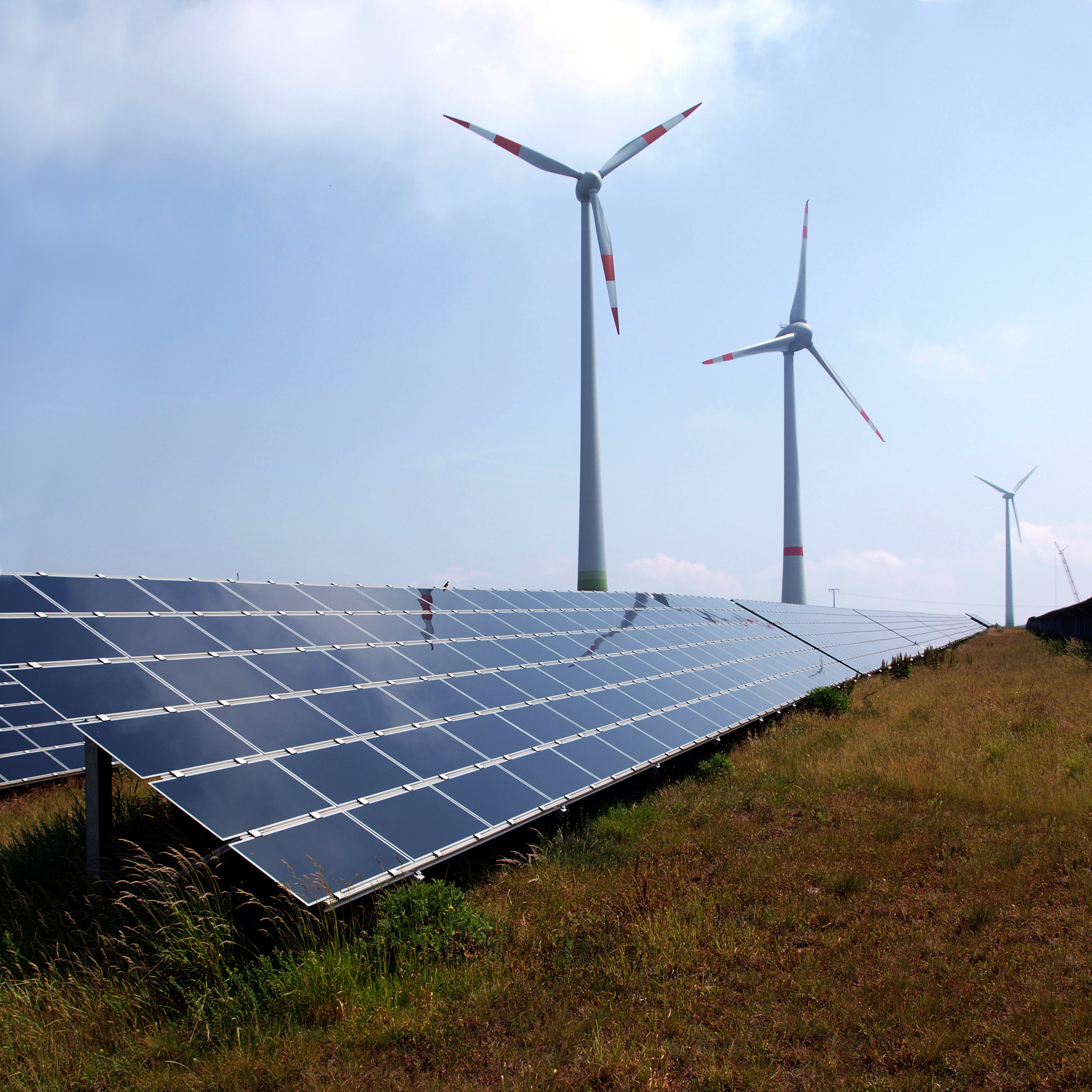
Figure \(\PageIndex{3}\): Photograph of Solar Panels and Wind Turbines.
However, in some countries renewable energy sources have seen a rapid increase in recent years. Germany, for example, has increased the renewables’ contribution to total electricity production from 3% in 1990 to 40% in 2018 (45% in 2020), while its economy has been one of the strongest in Europe. I have witnessed this transformation during my visits as more and more solar panels appeared on rooftops and wind turbines in the fields. Denmark plans to move to 100% renewable energy by 2050. In the United States renewables currently account for 10% of total energy consumption and 15% of electricity production and it is rapidly increasing. In 2016, e.g., its solar power capacity doubled. The advantage of renewables is almost unlimited potential supply with minimal carbon emissions (some emissions occur during the production and installation of solar panels and wind turbines) and that they are not associated with the dangers of nuclear power. Their disadvantages used to be their cost, particularly their high up-front investment cost. Once installed, however, solar panels and wind turbines operate almost without maintenance cost since solar energy and wind is free. During the past 10 years cost for solar panels have decreased dramatically by 80%. Thus, if viewed over the lifetime of a system renewables become competitive with fossil fuels. Other renewable energy sources are geothermal heat, tide and wave energy and hydroelectric dams. Another issue with renewables is their intermittent energy supply. Solar panels only work during the day, whereas wind turbines only work when the wind blows. However, a recent study showed that 80% of all electricity demand could easily be covered by wind and solar (Shaner et al., 2018).
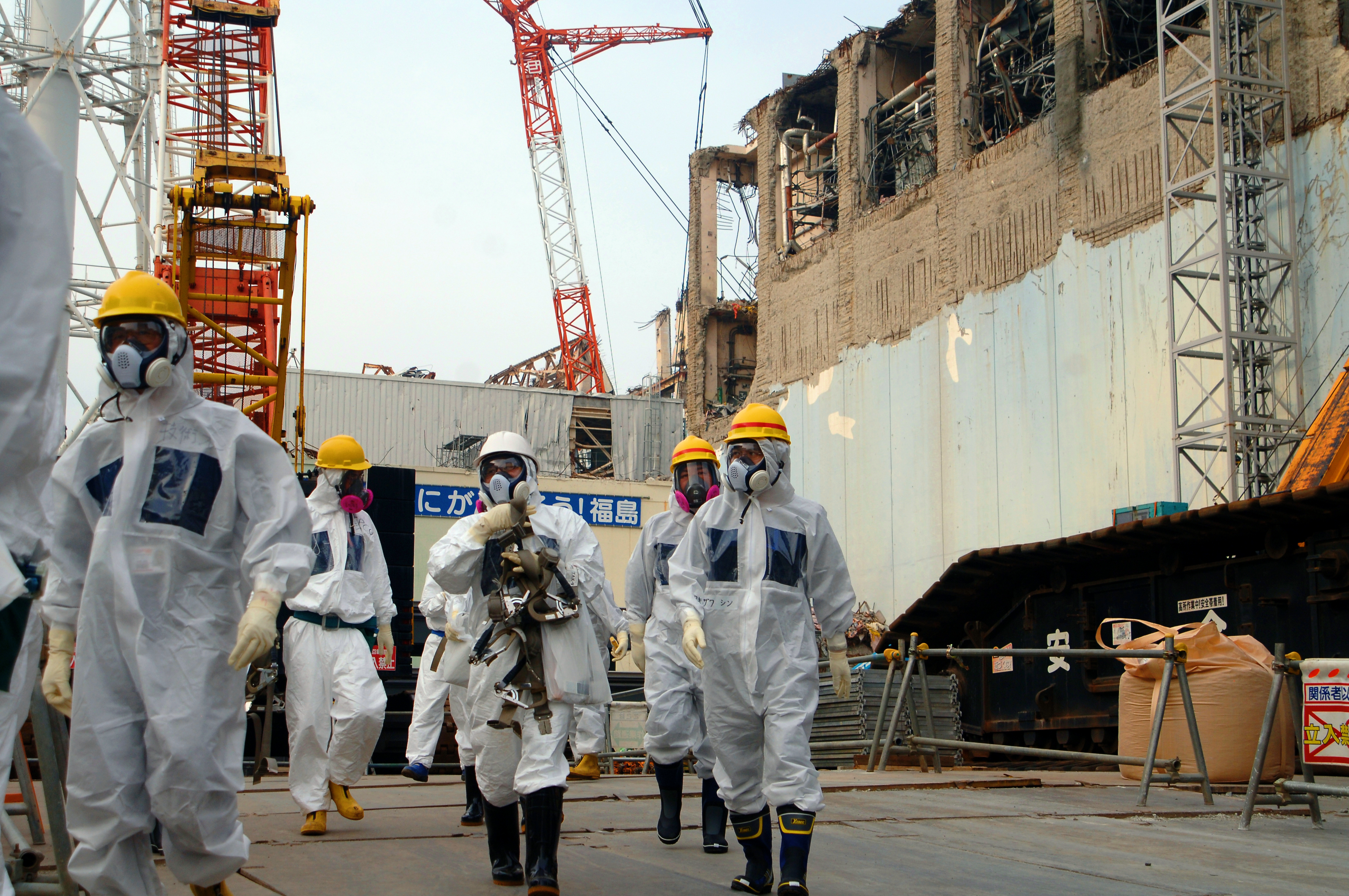
Figure \(\PageIndex{4}\): Photograph of Workers at the Damaged Fukushima Nuclear Reactor.
Nuclear plants also provide power that is fossil-free and does not cause carbon emissions (except during construction). For this reason they are viewed by some as an important future energy source. However, nuclear power has disadvantages too. Not only are they expensive to build they are also dangerous to operate and they produce radioactive waste for which currently no long-term repository exists. Catastrophic accidents such as the nuclear meltdowns in 2011 at the Japanese Fukushima Daiichi plant and in 1986 at the Chernobyl reactor in what is now northern Ukraine, have shown the dangers associated with nuclear power production. Thus, nuclear power remains a controversial topic.
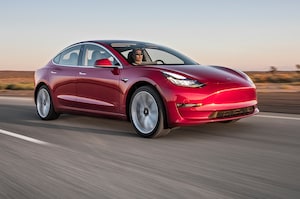
Figure \(\PageIndex{5}\): Photograph of an Electric Car.
Currently many companies move towards more electric cars or hybrid vehicles. Due to their much higher efficiencies (80-90%) their energy use is much smaller than for cars with internal combustion engines and their carbon footprint can be close to zero (some is associated with vehicle production) if renewable energy sources are used for the electricity. Even if fossil fuels are used for the electricity the carbon footprint of electric cars is still lower than that of internal combustion engine vehicles. Considering the large amounts of carbon emissions that currently come from the transportation sector and the large losses that occur there (Fig. \(\PageIndex{2}\) ) shifting to an electric vehicle fleet could bring a tremendous reduction in future emissions. Even though electric cars are more expensive to purchase their lifetime costs are lower than gasoline powered cars. This is because the average cost for equivalent electricity ($1.10) is less than half the cost for a gallon of gas ($2.50). Electric cars have other advantages too. No oil change, no pollution, more torque. Manufacturing electric cars, however, is not without environmental or human impacts, such as from the mining of raw materials used in the production of batteries.
Increasing energy efficiency is another cost-effective way to reduce carbon emissions. Fig. \(\PageIndex{2}\) shows that residential and commercial buildings waste about half of their energy. Building insulation does not only lower its carbon emissions but it also saves the owner money. When we bought our house it was not insulated. Adding insulation reduced our heating costs and made the house more comfortable to live in. It made it quieter too. A few years ago we also replaced our old conventional electrical hot water heater with an inexpensive new heat pump water heater. This simple change reduced our electricity bill by half.
Carbon capture and storage has been proposed and tested to reduce carbon emissions from fossil fuel powered plants or to remove carbon from the atmosphere. However, this technology is expensive, not well developed, and the storage in geological formations may be leaky. Here is an interesting video about natural and artifical ways to remove carbon from the air and store it in the ground.
Carbon capture and storage has been proposed and tested to reduce carbon emissions from fossil fuel powered plants or to remove carbon from the atmosphere. However, this technology is expensive, not well developed, and the storage in geological formations may be leaky.
b) Politics
In 1992 the United Nations Framework Convention on Climate Change (UNFCCC) was adopted at the Rio Earth Summit. It was ratified by 197 countries (Parties to the Convention). Its Article 2 states:
The ultimate objective of this Convention and any related legal instruments that the Conference of the Parties may adopt is to achieve, in accordance with the relevant provisions of the Convention, stabilization of greenhouse gas concentrations in the atmosphere at a level that would prevent dangerous anthropogenic interference with the climate system. Such a level should be achieved within a time frame sufficient to allow ecosystems to adapt naturally to climate change, to ensure that food production is not threatened and to enable economic development to proceed in a sustainable manner.
The UNFCCC recognizes that the developed world is responsible for most historical carbon emissions and thus it should lead the way to reduce its emissions. The Kyoto Protocol, an international agreement linked to the UNFCCC, commits its Parties, which are developed countries, to binding carbon emission reduction targets. However, it was not successful in reducing global carbon emissions, presumably at least in part because the United States has never ratified it, Canada has exited it and Russia has not agreed to emission reductions in its second phase (2013-2020). The US under the administration of President George W. Bush argued that it was not fair to reduce US emissions, while China was allowed to increase its emissions, even though per capita emissions in the US were much higher than those in China. The Paris Agreement has the goal to limit global warming to well below 2ºC and it was ratified by 174 countries. It has made emission reductions essentially voluntary by soliciting pledges from each country and includes developing countries like China. However, resistance against any reduction in carbon emissions was evident when the US administration under President Trump withdraw from the agreement although the current Biden administration has re-entered the agreement.
c) Personal Actions
Each of us can take individual actions to reduce carbon emissions and the impacts of climate change. Conserving energy e.g. by switching off lights when they are not needed. Switching to energy efficient appliances such as LED lights. Recycling also helps. Driving less or choosing an energy efficient car like a hybrid or an electrical car or a smaller vehicle will reduce your carbon footprint. Even better is riding your bike. I like to ride my bike not only because I want to reduce carbon emissions but also because it is fun and it is healthy. It’s my daily exercise. Not flying so much also helps. I use skype to communicate with my family in Germany. Eating less meat is another way to reduce your carbon footprint because meat production requires more carbon emissions than vegetarian food. I’m not a vegetarian myself but I like tasty vegetarian food. Homeowners can weatherize their homes or install solar panels. We’ve installed 20 solar panels in 2017. The system produces enough electricity for all of our family needs including that for an electric car. There are many things we can do as individuals. You can check your own carbon footprint at various websites such as this to help you with this process.
Ultimately, however, individual actions have limited effects. Imagine, for example, that you start using less gas by riding your bike instead of driving your car. If many people would do it this would reduce demand for gas and it would make gas cheaper, assuming supply stays constant. Cheaper gas has the effect that other people buy larger cars and use more gas, thus diminishing or erasing the effects of your personal emission reduction. I’m not saying that we should not take individual actions. To the contrary. I think it is important that everybody does her/his part in making the world a better place and that we act in accordance with our believes. However, we should not have delusions as to the effects of individual actions. Therefore I believe collective action is also needed. In my opinion only governmental actions such as a carbon tax or a cap-and-trade system will be able to accelerate the transition to renewable energy sources that we need to avoid potentially dangerous climate change. Thus, perhaps the most important individual actions we can take is to vote and to engage in the political process to make change happen. Part of that is talking to family, friends, neighbors and politicians.
d) Adaptation
Climate change does already affect us. It is not only a thing of the future or of far-away places. It is an issue of the here and now. Since we cannot avoid further climate change in the immediate future we will have to adapt to it if we don’t want to suffer its consequences. Perhaps one of the most important things is to be aware that it is happening. This will make us think about possible consequences for the region we live in. If regional projections are available we can consider them in planning. If not we can still extrapolate past changes according to the principle that we can expect more of what we’ve observed in the recent past. In Oregon, for example, we can expect less snow pack and lower summer stream flows. Eastern Oregon, which is already dry, can expect even dryer conditions. Along the coast sea levels will continue to rise and the ocean will continue to acidify. Regionally changes in sea level or ocean acidification may be different from global mean changes.
Questions
- What is mitigation of climate change?
- What is adaptation to climate change?
- What are the two main reasons for the increase in historical carbon emissions?
- What is the Kaya Identity?
- Considering the Kaya Identity, what could be done to reduce carbon emissions in the future?
- List five things that can be done to mitigate climate change.
- What is the goal of the United Nations Framework Convention on Climate Change as expressed in its Article 2?
- What personal actions would you consider to take in order to mitigate climate change impacts?
- Why will we need to adapt to future climate change impacts?
- Think about a particular region/country of the world that may be affected by climate change. What measures could be taken to adapt to the changes?
References
GEA (2012) Global Energy Assessment – Toward a Sustainable Future, Cambridge University Press, Cambridge, UK and New York, NY, USA and the International Institute for Applied Systems Analysis, Laxenburg, Austria. html
IPCC (2014) Climate Change 2014: Mitigation of Climate Change. Contribution of Working Group III to the Fifth Assessment Report of the Intergovernmental Panel on Climate Change [Edenhofer, O., R. Pichs-Madruga, Y. Sokona, E. Farahani, S. Kadner, K. Seyboth, A. Adler, I. Baum, S. Brunner, P. Eickemeier, B. Kriemann, J. Savolainen, S. Schlömer, C. von Stechow, T. Zwickel and J.C. Minx (eds.)]. Cambridge University Press, Cambridge, United Kingdom and New York, NY, USA. html
Shaner, M. R., S. J. Davis, N. S. Lewis, and K. Caldeira (2018) Geophysical constraints on the reliability of solar and wind power in the United States, Energy & Environmental Science, doi: 10.1039/C7EE03029K.


